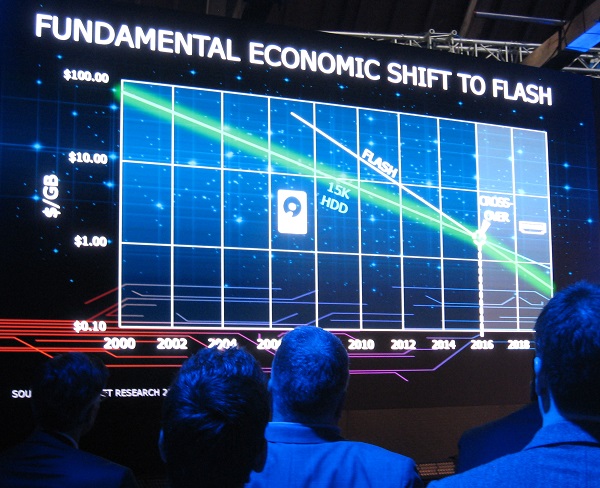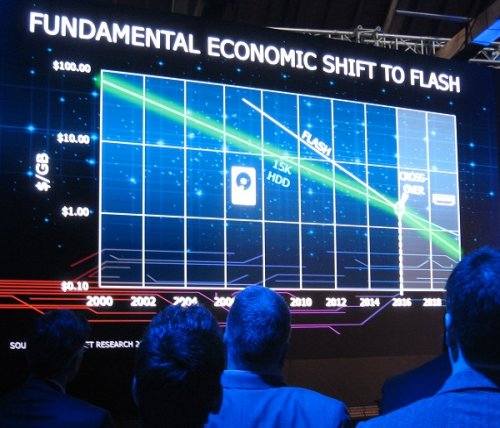 Falling prices make flash storage cheaper than enterprise disk; EMC and others step up to take advantage and open up new application areas
Falling prices make flash storage cheaper than enterprise disk; EMC and others step up to take advantage and open up new application areas EMC is switching to flash for its new storage designs. Higher flash drive density, lower failure rates, lower power consumption and operating temperatures relative to traditional disk arrays also contribute to enterprise storage platforms that require less data centre floor space, power and cooling.

It released a swathe of new products which use flash this week; it is already market leader, according to IDC’s most recent Worldwide Quarterly Disk Storage Systems Tracker, with 39% of all-flash storage solutions, more than the next three competitors combined and is also the market share leader in enterprise storage solutions that include both all-flash and hybrid flash storage arrays. It wants to drive that market share up to over 50%, it says.
In future, EMC storage solutions based on hybrid configurations will be offered primarily for bulk data storage capacity and archive requirements. 2016 is the year of flash, it proclaims as falling prices make it viable and its extra reliability makes it an obvious choice for enterprise systems. “For all the applications built in the last 15 years, it makes an ideal consolidation platform, but it will also open up new opportunities,” says Jeremy Burton, President of Products and Marketing.
“We’re expanding upon EMC’s primary storage strengths and all-flash leadership, built with XtremIO. With the introduction of VMAX All Flash and DSSD D5 there is virtually no data centre use case we’re unable to address from traditional high-end enterprise workloads, to use cases that people haven’t even dreamt about.”
With a new products category –“Rack-Scale Flash Storage” - for the SSD D5 it will offer a way to upgrade systems and offer lower power, increased performance, it says. “It will things very different in future,” he says, giving examples of its uses in big data analysis in real time. And given Moore's law, the prospect of IT being 1000 times faster in just fifteen years' time, there will be a need for such products. “We're very proud of the network storage array – we've made a lot of money from them- and all the important applications in business, they run very well. But for all the next generation applications coming down the line we think we will need a new architecture. We need the very high performance of direct-attached storage, but without the single point of failure.”
The result is the five year plan culminating in Rack-Scale Flash, which is performance-centric, and is designed for enterprise business critical systems, he says. With flash prices continuing to fall, and the devices themselves scaling faster than Moore's Law and the rest of IT the future path seems to be set.
- Not that EMC will have it all its own way. The special day when it launched also saw announcements from NetApp, announcing all-flash FlexPod automation with its partner Cisco, and Tegile with availability of IntelliFlash HD and a new entry-level all-flash array.